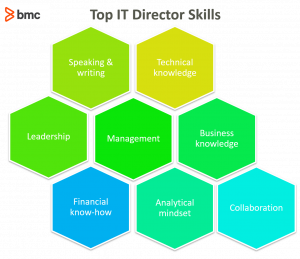Nearly every sizable organization has at least one director of technology – and many companies have more than one. Depending on the scale and purpose of a company, the role of the director of technology can vary greatly. And, the larger the company, the more IT directors there may be.
As a director of technology, your set of responsibilities may include overseeing the infrastructure of technical operations, managing a team of IT employees, tracking technology in order to achieve business goals, eliminating security risks, increasing user satisfaction, and maintaining operations and systems.
In this article, we are looking at the vital position of director of technology, including the roles and responsibilities, candidacy requirements, and the future of the role.
The IT Director title
Director of technology is only one title for this general set of job requirements. Other similar titles can include IT Director, Senior IT Director, and Director of Information Technology. The position often falls under Computer and Information Systems Managers.
Peers and reporting
Looking up the career ladder, a director of technology often reports directly to the Chief Technology Officer (CTO), providing updates and requesting resource support for the entire technology team that the director oversees.
Within your role, you’ll likely oversee one or several IT teams and you may work alongside several other IT directors, all with responsibilities around various technologies and team functions.
Roles and responsibilities
Just as important as who the director of technology reports to is who the director of technology oversees and leads. While a director’s role seems to cover a lot of systems, it’s really the people that the director oversees. A director of technology is likely responsible for answering these questions:
- Are individual IT teams achieving their goals?
- Are the teams having issues bringing their product or solution to the finish line?
- Are other departments supporting the IT department in providing the necessary support, resources, infrastructure, etc.?
The ways you’ll answer these questions will depend on a lot of factors including:
- Size of your company
- Technologies you deploy
- Overarching philosophy of technology within your enterprise
- Your scope as the, or a, director of technology.
Keep in mind that the organization’s industry will have an impact on the job itself. Education, government, non-profit, and healthcare sectors combined comprise nearly one-third of the director of technology positions nationwide. Smaller percentages go to financial, business, and software services, respectively.
- Developing and overseeing SMART (specific, measurable, attainable, relevant, time-based) metrics for hardware, software, and storage
- Ensuring strategic capacity planning
- Managing all or part of the IT department, including:
- Directly supervising some employees
- Hiring certain members
- Handling employees’ concerns and performances
- Communicating with the technology team and other departments as collaboration requires
- Determining business requirements for IT systems
- Identifying and eliminating security vulnerabilities with strategic solutions that increase data security
- Directing and supporting the implementation of new software and hardware
- Identifying and recommending new technology solutions
- Managing the organization’s help desk (internal, external, or both)
- Coordinating IT activities to ensure data availability and network services with as little downtime as necessary
- Overseeing departmental finances, including budgeting and forecasting
- Implementing executive policies
- Reporting back to the C-suite level
IT director skills needed
As a director, your work will be a balance of looking inward towards your team and responsible technologies as well as working outwards to understand business needs across various departments. As such, your professional skills require breadth perhaps more than expertise in a single area.
The skills needed to be a successful IT director include:
- Technical knowledge, so you can understand without being too lost in technical details
- Communication, both written and verbal, as you’ll need to communicate with technically-minded employees and non-technical colleagues
- Leadership and management skills
- Analytical mindset to develop and utilize reliable metrics
- Understanding of other, non-technical parts of the business
- Cooperation and collaboration
- Financial skills including budgeting, forecasting, and justifying

Education and requirements
Common requirements for a director of technology position include:
- A B.S. in programming, computer science, computer engineering, or a related field
- Several years’ experience managing employees within an IT environment
- Several years’ experience working with particular systems that are relevant to your company – for instance, EMR/EHR systems in healthcare technology, or finance-specific databases for mutual funds and banking institutions
Additional education can be helpful, too. One-third of current directors hold a Masters-level degree, such as an MS in information technology or an MBA focusing on tech or business.
You may not need to be an expert in multiple programming languages or certified in every network, but you must possess a broad understanding of tech theories and applications from a macro-level. You’ll also need to understand new trends and shifts in technology, considering what may benefit your IT department while balancing your organization’s business needs and budget.
Professional development for IT director
Once you’re in an IT director position, your formal education doesn’t end. Quite the opposite in fact: you may want to partake in professional development opportunities in order to stay abreast of the latest trends, emerging management theories, and how innovation is changing your field.
As a director, your IT development doesn’t need to be extremely technical. You can undertake introductory courses in the ITIL Foundation to improve and better manage your IT services, particularly if your company has already adopted the ITIL framework.
Or, you may want to focus on broader, management-minded opportunities like MBAs with a focus on IT management or related certificates.
Remember, though, that professional development doesn’t have to be formal. Some of the best ways to continue developing as a director are to stay curious and to partner with a mentor.
- Staying curious. This can be as simple as a reading up on trade magazines or business journals that illustrate innovations in IT and cross-sectional fields. Or, attending a conference outside your normal comfort zone may open up opportunities or ways of thinking you were unaware of.
- Seeking a mentor. A mentor could be someone who shows you other ways of doing things, based on his or her own experience. Consider more senior directors within your IT department, non-IT directors within your company, and even directors or executives outside of your company altogether. Their experiences can show you different approaches to IT and management thinking. Plus, their advice can provide support as you hit professional roadblocks.
Salary and job outlook
The good news is that IT directors in the U.S. are quite well-paid, with the median salary across private, government, and non-profit sectors clocking in at just above U.S. $142,500.
The U.S. Bureau of Labor Statistics (BLS) projects that the demand for directors of technology will grow about 12 percent by 2026, much faster than the national average of all occupations (average 8%). This increased demand for such candidates stems from the growth into digital platforms that nearly all businesses will adopt. In addition, they’ll need directors and managers to implement these growth goals.
Further, as cyber threats inevitably increase, IT teams will have to spend more time bolstering their cybersecurity practices and protocols. The BLS predicts that this cybersecurity requirement will affect the healthcare and insurance carrier industries in particular. Because of rapid change and growth in the IT field, candidates for director of technology positions must stay abreast of the newest technologies.
Of course, becoming an IT director doesn’t mean you’ve reached the pinnacle of your career. You may seek to consolidate IT teams by moving up the ladder, perhaps eventually securing a CIO or VP of technology role. With technology vital to business, opportunities for career growth about.







